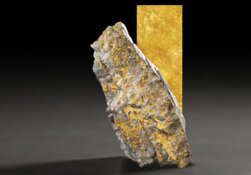Gold ended the week at $1,350, with silver at $29.11. Bloomberg News reported February 4, "Gold declined in London, trimming the first weekly gain this year, on expectation that an economic recovery will curb demand for the metal as an alternative investment." The expectation arrived Friday. As Alix Steel of The Street reported, "Gold prices had been shielding themselves for a good jobs number with the unemployment rate expected to rise to 9.5% because more people entered the labor force while the private sector is expected to add 160,000 jobs. However, the U.S. economy added only 36,000 jobs and the unemployment rate dropped to 9%. Still, Wall Street seemed to shrug off the data which put some pressure on gold prices."

Perhaps Wall Street, which enjoyed its best January in 14 years, is too giddy to notice there is something distinctly curious about American labor statistics. As Mike Shedlock wrote on his blog: "The unemployment rate (based on the household survey), unexpectedly fell from 9.4%–9.0%. How did that happen? Based on population growth, the labor force should have been expanding over the course of a year by about 125,000 workers a month—a total of 1.5 million workers. Instead, (for the entire year) the BLS reports that the civilian labor force fell by 167,000 (i.e., those not in the labor force rose by 2,094,000). In January alone, a whopping 319,000 people dropped out of the workforce."
In the U.S., people who stop looking for work, the "chronically discouraged," are no longer considered "unemployed." At Zero Hedge, Tyler Durden reports, "At 64.2%, the labor force participation rate (as a percentage of the total civilian non-institutional population) is now at a fresh 26-year low, the lowest since March 1984. Those not in the labor force increased from 83.9 million to 86.2 million—or 2.2 million in one year!" One Zero Hedge reader comments, "That's odd. I don't hear much about this number in the MSM." No, indeed. As it turns out, from a statistical point of view, it is very much in the interest of the U.S. government for the chronically discouraged to remain so. Should that 2.2 million start looking for work again, the official unemployment rate would skyrocket.
The Bureau of Labor Statistics (BLS) publishes an "alternative" unemployment figure, one that includes all those working part time not by choice. January's rate was 16.1%. According to Gallup, which surveys 30,000 Americans on this question, the rate is 19.2%.
So it is entirely possible to conclude that the biggest economic stimulus in American history has little to show for it—except, perhaps, a reckoning. On that score, Nassim Taleb is withering. Bloomberg reports February 3, that the author of The Black Swan told a Moscow conference, "We have a very dire situation in the United States, and every day that goes by it gets worse. Every day that goes by, we're spending money. We're increasing that cumulative debt." He compared the United States to basket case Greece and said investors should at all costs avoid U.S. treasuries and the U.S. dollar. Why so down on the dollar? "Euros have Germany, the dollar has nothing."
It was not reported whether Taleb had anything to say about gold, but the Financial Times reported February 2 that the Chinese are mad for it. "China's gold imports are estimated to have more than doubled from a year ago in the run-up to Chinese new year, putting the country on track to overtake India as the world's largest consumer of the precious metal. . .Precious metals traders in London and Hong Kong said on Wednesday they were stunned by the strength of Chinese buying in the past month. 'The demand is unbelievable. The size of the orders is enormous,' said one senior banker, who estimated that China had imported about 200 tons in three months."
Despite the slight fall on Friday, the gold market is bullish again. Even before Newmont bought Fronteer for $2.3 billion, Derrick Penner wrote in the Vancouver Sun February 1, "Mining. . .is expected to dominate M&A [mergers and acquisitions] in a year that could surpass 2010. This is, of course, to quote a bad cliché, the time to 'make hay while the sun shines' for mining firms. It's a good time to be mining, or opening a mine. Or, if you don't have a mine to open, as one analyst once told me, it is perhaps easier to buy someone else's mine than try to discover a new one of your own."
On February 1, Reuters reported that Colombia "is hot again," both in terms of exploration and M&A. "Seemingly overnight, its nearly dormant gold-mining industry has stirred to life, and the country has become a mecca for junior miners searching for the next big find." The story quotes Medoro Resources Board Member Robert Doyle, who enthuses, "It has a good, clean, democratic government. . .And it has very clear, well-defined mining laws and environmental laws." Other companies mentioned here are Continental Gold Ltd. (TSX:CNL), Ventana Gold and Greystar Resources.
One hot Canadian explorer is Detour Gold Corporation (TSX:DGC). Martin Mittelstaedt wrote in Globe and Mail February 2 that Detour "likes to bill itself as the exploration company holding Canada's largest undeveloped gold deposit. This week, the estimates of the size of that deposit got significantly larger, causing analysts to upgrade their stock targets while renewing speculation that the company could be in line for a takeover by a major producer." Blyth has "nearly tripled his target price to $0.40 (from just $0.14)" and concludes, "This is a [1.5 million ounce] gold reserve, feasibility complete, permitted and ready to build—all held within a company with a current market cap of $112 million."
Shirley Won reports in the February 2 Globe and Mail that the Top 10 equity holdings in the BMO Precious Metals fund as of December 31, 2010, were Rainy River Resources, Sandspring Resources Ltd. (TSX.V:SSP), Trelawney Mining, Allied Nevada Gold Corp. (TSX:ANV; NYSE.A:ANV), Keegan Resources, Orezone Gold, Semafo Inc., Tahoe Resources, Kinross Gold and Goldcorp Inc. (TSX:G; NYSE:GG).
At Seeking Alpha January 31, Michael Bryant responds to the question: "Will silver outperform gold?" with, "Can't you own them both?" He argues, "Paramount Gold and Silver appears to be ideal for this."
Also at Seeking Alpha, Kurtis Hemmerling touted the following silver stocks February 3: Silvercorp Metals, Pan American Silver, Silver Wheaton, Silver Standard Resources, First Majestic Silver, Coeur d'Alene Mines, Endeavour Silver, Hecla Mining, Mines Management and Mag Silver.
Finally, those who believe the Internet is responsible for raising a generation of suckers are invited to familiarize themselves with the the Great Spaghetti Tree Hoax of 1957. Reactionaries of that time were wont to blame contemporary gullibility on the then-new media of television, but a truer villain is human nature, which is eternal.
Critical Thinking










































